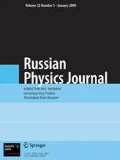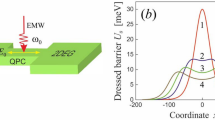Based on the developed mathematical model, the radiationless electronic excitation energy transfer by surface plasmons between molecules adsorbed on a conductive film is investigated. A dependence of the rate of energy transfer on the geometrical system parameters is established. It is demonstrated that the presence of the plasmon channel increases up to two orders of magnitude the probability of energy transfer in comparison with the direct dipole-dipole interaction between the donor and acceptor spaced at the same distance in vacuum.
Similar content being viewed by others
References
G. S. Plotnikov and V. G. Zaitsev, Physical Principles of Molecular Electronics [in Russian], Publishing House of Physics Faculty of Moscow State University, Moscow (2000).
V. V. Klimov, Nanoplasmonics [in Russian], Fizmatlit, Moscow (2009).
L. Novotny and B. Hecht, Principles of Nano Optics [Russian translation], Fizmatlit, Moscow (2011).
V. V. Klimov, M. Ducloy, and V. S. Letokhov, Kvant. Elektr., 31, No. 7, 569–583 (2001).
H. T. Dung, L. Knöll, and G. G. Welsch, Phys. Rev., A65, 043813 (2002).
D. Jankovski, P. Bojarski, P. Kwiek, and S. Rangelova-Jankovska, Chem. Phys., 373, 238–242 (2010).
F. Reil, U. Hohenester, J. R. Krenn, and A. Leitner, Nano Lett., 8, 4128 (2008).
A. O. Govorov, J. Lee, and N. A. Kotov, Phys. Rev., B76, 125308 (2007).
T. M. Chmereva and M. G. Kucherenko, Russ. Phys. J., 54, No. 3, 301–307 (2011).
T. M. Chmereva and M. G. Kucherenko, Opt. Spektrosk., 110, No. 5, 819–826 (2011).
M. G. Kucherenko, D. A. Kislov, and T. M. Chmereva, Russian Nanotekhn., Nos. 1–2, 71–77 (2012).
P. Andrew and W. L. Barnes, Science, 306, 1002 (2004).
N. Kh. Ibraev and V. A. Latonin, Fiz. Tverd. Tela, 41, No. 4, 736–739 (1999).
G. E. Dobretsov, Fluorescent Probes in Investigations of Cells, Membranes, and Lipoproteins (Table of Luminescent Probes) [in Russian], Nauka, Moscow (1989).
Author information
Authors and Affiliations
Corresponding author
Additional information
Translated from Izvestiya Vysshikh Uchebnykh Zavedenii, Fizika, No. 10, pp. 116–121, October, 2014.
Rights and permissions
About this article
Cite this article
Chmereva, T.M., Kucherenko, M.G. Intermolecular Radiationless Electronic Excitation Energy Transfer Near A Conductive Film. Russ Phys J 57, 1428–1435 (2015). https://doi.org/10.1007/s11182-015-0399-7
Received:
Revised:
Published:
Issue Date:
DOI: https://doi.org/10.1007/s11182-015-0399-7




